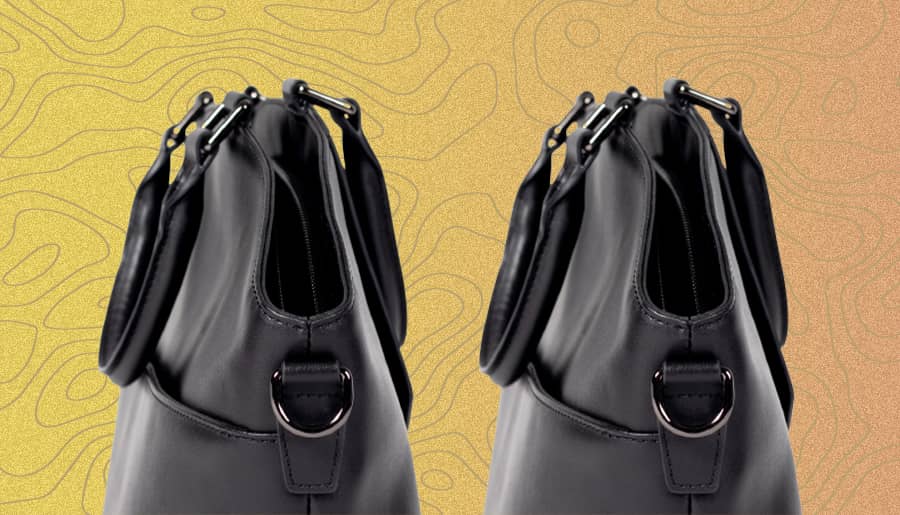Gone are the days of ‘pleather’ being looked down upon and considered the lesser version of real leather. Today, ‘pleather’ or ‘artificial leather’, now most often called ‘vegan leather’, is generally viewed as a more sustainable alternative to real leather, able to be used for jackets, handbags, shoes and more.
But, in saying that, not all vegan leather is created equal. Innovation in textiles have come a long way and there are now countless types of vegan leather on the market, including many made from synthetic materials that in fact worse off for the environment than regular leather.
To give you an idea of just how many different types of vegan leather there are, and just how much their materials and production methods vary, ahead, Tessa Carroll, founder of vegan handbag brand A_C Official, breaks down six of the main types of it. From PU and PVC, to mushroom and pineapple, these are some of the most common vegan leathers.
PU and PVC
“Polyurethane or Polyvinyl-chloride are the most common ‘vegan leathers’, and also the cheapest and poorest quality. And for a reason – as mentioned, they are literally plastic. Plastic is a derivative of petroleum oil, drilled up from the Earth, releasing tonnes of carbon emissions, and ultimately, causing exponential damage to our climate.
“As these textiles age they start to peel, however, being plastic, they don’t ever biodegrade, so even though they have a relatively short shelf life they spend the next 200+ years in landfill releasing carbon emissions. There is now technology that allows the fashion industry to recycle PU, which is undeniably better than virgin PU or PVC, however, it is still plastic and there is still no end-of-life plan for it once it is no longer usable.”
Silicon Leather
“Sileather or silicon leather is a super sustainable fabric created from silica sand that is recyclable and entirely PU and PVC-free. The production process is 9x less carbon intensive than PU, and unlike PU and PVC fabrics, Sileather does not use solvents or chlorine in the production process, and it does not leak VOC emissions throughout its life.
“It’s my opinion that it actually feels even better than leather, with a luxurious texture. It’s also incredibly durable, waterproof and easy to keep clean.”
Pineapple Leather
“Pineapple leather, also known as “Piñatex”, is made from the discarded leaves of the pineapple plant. It’s such a cool innovation as it’s not only taking the by-product of an existing industry and creating something beautiful and useful, it also provides a secondary income stream for the farmers, creates more jobs in the local community, and the machinery that turns the waste product into textile can be run by the biogas that the harvest creates.
“In terms of appearance, Piñatex has a crinkly appearance similar to an elephant’s skin, and there are a wide variety of colours available. Our first ever A_C collection was made from Piñatex.”
Cactus Leather
“Desserto cactus leather is a new innovation that only launched at the end of 2019 and has already won numerous design awards, including being named finalist at the LVMH Innovation Awards. The sustainable leather alternative is derived from the cactus plant ‘Nopal’ or ‘Prickly Pear’ as it is most commonly known.
“Harvesting from their Mexican cactus ranch, the innovators are able to avoid soil degradation as plants are not removed from the ground and only the mature stems are used in the textile’s raw materials. The plantation regrows quickly with rainwater only, taking 6-8 weeks to be ready for harvest again, before cuttings are transported to their textile facility to be made into the patented bio-based leather alternative.
“While cactus leather is not fully biodegradable and does contain 1-2% poly on its surface, Desserto are working on improving this. Aside from its sustainability credentials, one of the most exciting things about this textile is that it really looks and feels like leather.”
Cork Leather
“Cork is a more unusual leather alternative and actually one of the most eco-friendly options. The cork bark is stripped from the living tree to make the textile, so the tree continues to grow and produce more bark without any degradation to the soil and surrounding environment.
“The planting of cork trees is also beneficial to the planet as they aid in the absorption of CO2. Once the cork leather product reaches its end of life it is recyclable and biodegradable. The only downside is that aesthetically, it doesn’t look much like leather at all.”
Mushroom Leather
“Mushroom leather is still a work in progress and it’s not quite commercially viable yet, however I’m predicting it will be the best innovation the industry will see in the leather alternative space. The name ‘mushroom leather’ is actually a little bit misleading – it’s made of mycelium which is the lattice-like network of fungi, and mushrooms are essentially the fruit of mycelium.
“One of its many benefits is that mushroom leather is able to be ‘grown’ and then compressed in the textures, weights and colours desired. Watch this space as we are currently sampling this amazing textile.”
Read more stories from The Latch and subscribe to our email newsletter.







